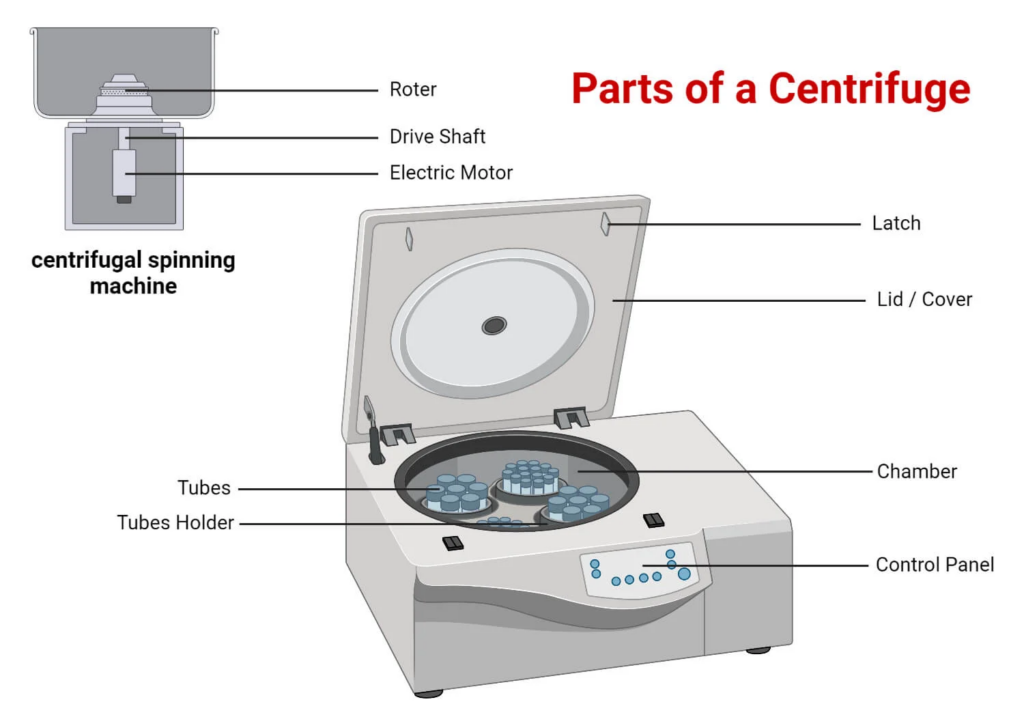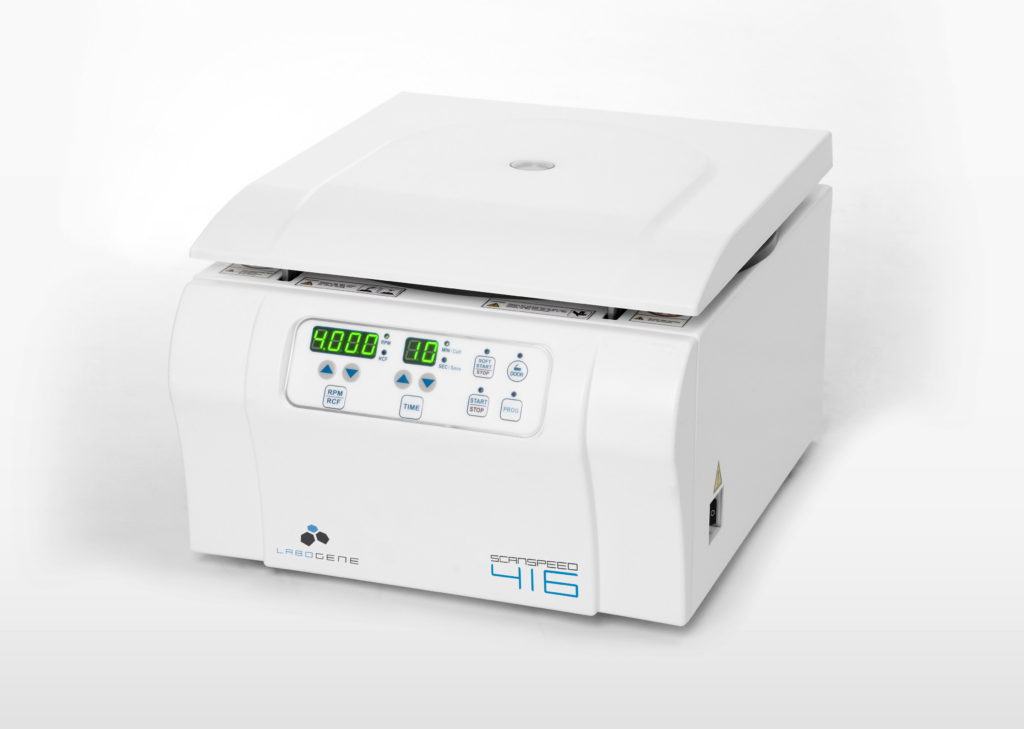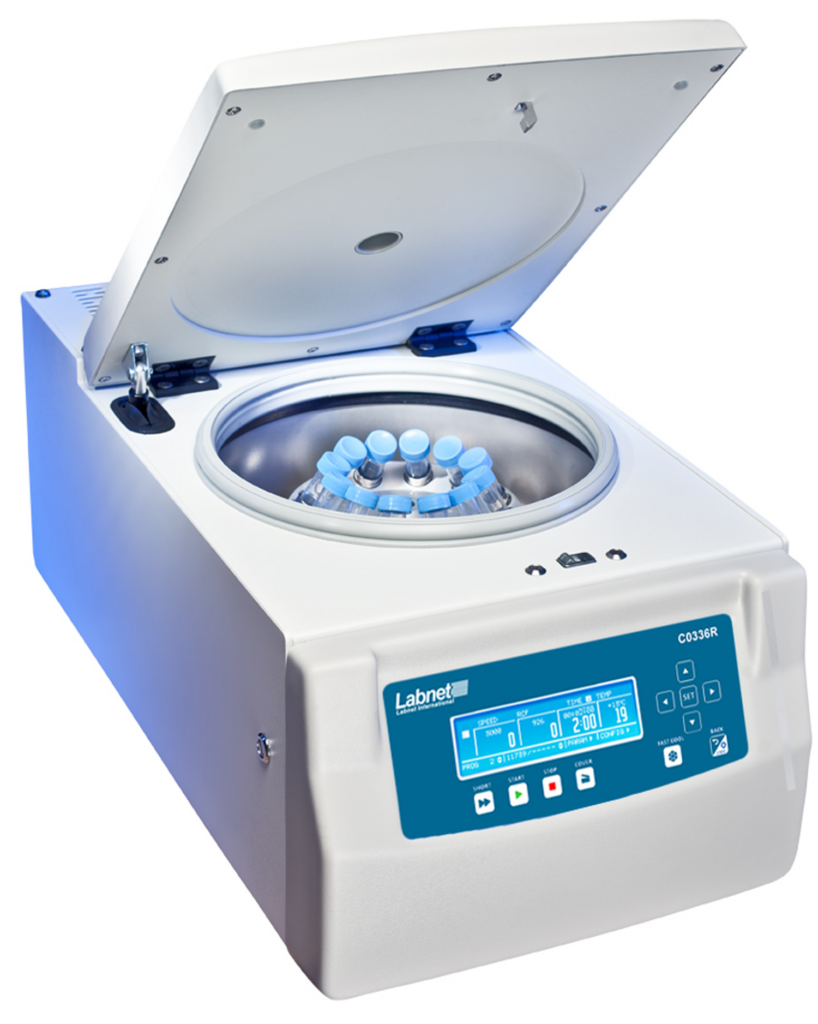A centrifuge is a scientific instrument that uses high-speed rotation to separate different components in fluids, gases, or liquids based on their density. By spinning a container at a rapid pace, heavier materials move towards the bottom due to centrifugal forces. This method is particularly effective when dealing with substances that don’t readily mix. Centrifuges have widespread applications in various industries, including beverages, oils, fats, as well as scientific, medical, and industrial fields such as cell biology, clinical diagnostics, blood banks, and wastewater treatment.

Centrifuges come in different sizes and designs, ranging from compact benchtop models used in laboratories to large industrial machines employed in manufacturing processes. This post will explore the many kinds, benefits, and crucial factors to take into account while choosing the best centrifuge.
Interesting Science Videos
What is Centrifuge?
A centrifuge is an instrument that separates mixture components based on size, density, medium viscosity, and rotor speed. It is commonly used in laboratories to separate biological components from raw extracts.
In a centrifuge, a sample is placed in a rotor that spins around a fixed axis. This rotation provides a strong force perpendicular to the axis, making it easier to separate components. Centrifuges are used for a variety of molecular separations, although they all follow the same basic principle: sedimentation. Utilizing centrifugal force, a centrifuge enables accurate particle separation and purification, establishing itself as an essential tool across diverse fields.
There are various types of centrifuges, such as high-speed, low-speed, and ultracentrifuges. High-speed ones are employed for separating cells and biological materials, while low-speed ones handle non-biological substances like crystal suspensions or inks. Ultracentrifuges, on the other hand, are used for separating extremely small particles and for measuring particle size, shape, and density.
Centrifugation is a widely adopted technique in research, industry, and clinical labs with diverse applications. It is utilized for purifying biological samples, separating cells and organelles, analyzing proteins and nucleic acids, and preparing diagnostic specimens. Centrifuges play a crucial role in various scientific and industrial processes due to their versatility and effectiveness in handling a broad range of materials.
Principle of Centrifugation
Centrifugation relies on the behavior of particles in a solution, where those with higher density settle and those with lower density rise. The process utilizes a powerful centrifuge, not gravity, to generate a strong outward force by rotating an object around a fixed axis.
Operating on the sedimentation principle, the centrifuge induces centripetal acceleration, causing denser substances to move outward, forming a pellet at the bottom of a sample tube, while less dense substances rise to the top. This separation is based on the relative densities of components.
Centrifugation is a crucial technique in various scientific fields, aiding in the separation and purification of materials like cells, proteins, and nucleic acids. It finds applications in biology, biochemistry, chemistry, and clinical diagnostics, allowing efficient and precise analysis of complex mixtures.
Centrifugation is a technique that separates particles based on size, shape, density, and viscosity using centrifugal force generated by the rotation of motors. Several factors influence the process:
- Density of Samples: Particles with higher density settle down, while those with lower density float or stay suspended in the solution.
- Viscosity and Temperature: The rotation of motors increases temperature, disrupting particle bonds and stability. Higher temperature aids in particle separation. Additionally, higher viscosity in a sample makes it easier to separate its components.
- Distance of Particle Displacement: A greater distance of particle displacement leads to a higher rate of separation.
- Speed of Rotation: The higher the rotation speed, the faster particles separate due to increased centrifugal force.
- Relative Centrifugal Force (RCF) or G-Force: The acceleration applied to the sample is known as RCF or G-force. When RCF surpasses the frictional force, particles move away from the axis of rotation, contributing to effective separation.
What is Relative Centrifugal Force (RCF)?
Relative Centrifugal Force (RCF), also known as G-force, is a measurement that quantifies the acceleration experienced by an object in a centrifuge. It is particularly useful when comparing the strength of centrifugal forces in rotors of different sizes and types.
The formula for calculating RCF is given by:

Where:
- r is the radius of the rotor (in centimeters)
- RPM is the speed of the rotor in rotations per minute
This formula illustrates that RCF is directly proportional to the square of the rotor speed (RPM)2
and the radius of the rotor (r). As the speed or the radius increases, the RCF also increases exponentially. RCF is a crucial parameter in centrifugation, as it determines the force applied to particles in a sample, influencing their separation during the centrifugation process.
Parts/Components of Centrifuge

Motor: The motor stands as the central powerhouse of the centrifuge, generating the necessary rotational force for the spinning process.
Rotor Assembly: The rotor assembly consists of a drive shaft and a rotor. The drive shaft provides structural support, while the rotor, linked to the motor, houses containers (tubes) for the samples to be centrifuged. It converts electrical energy into mechanical energy. There are three primary types of rotors:
- Fixed Angle Rotors: These hold tubes at an angle of 14 to 40°, promoting short-distance particle travel. Ideal for differential centrifugation, particles sediment along the tube walls due to the consistent direction of centrifugal force.
- Swinging Bucket/Horizontal Rotors: Rotors and tubes swing out horizontally during acceleration, allowing particles to travel a longer distance. This facilitates easier separation of supernatant from the pellet and is commonly used in density gradient centrifugation.
- Vertical Rotors: Holding tubes vertically parallel to the motor axis, these rotors are suitable for isopycnic and density gradient separation. However, they are not preferred for pelleting as the pellets spread along the entire outer tube wall due to centrifugal force.
Containers: Various containers, including test tubes, blood bags, cuvettes, and centrifuge tubes, are accommodated in the rotors. These containers hold the samples securely as they rotate along with the rotor.
Control Panel: The control panel is responsible for regulating different parameters such as temperature and rotational speed (measured in rcf or rpm). It provides the user with operational control and customization.
Latch: In the event of a tube breakage or other issues while the centrifuge is in operation, the latch ensures the lid remains securely closed. This safety feature prevents mishaps and promotes safe usage.
Lid: The centrifuge will only initiate the spinning process when the lid is closed and securely locked. This safety mechanism is crucial for preventing accidents and maintaining a secure operating environment.
Types of Centrifuge
Low-Speed Centrifuge
Low-speed centrifuges, commonly found in labs, spin at 4000-5000 rpm. They’re user-friendly and compact, suitable for routine tasks like sorting particles in blood and biological samples. However, they lack temperature control.

[Image source: https://www.labogene.com/]
High-Speed Centrifuge
High-speed centrifuges, operating between 15,000 and 30,000 rpm, are for advanced labs in biochemical applications. They have controls for temperature and speed, crucial for studying delicate biological molecules. These centrifuges are adaptable with various sample tube sizes.

[Image source: https://www.beckman.com/]
Ultracentrifuges
Ultracentrifuges, with speeds up to 150,000 rpm, specialize in separating smaller molecules like proteins and viruses. They use refrigeration to control generated heat. Apart from separation, they analyze characteristics like size and shape of macromolecules.

[Image source: https://www.beckman.com/]
Microcentrifuges
Microcentrifuges spin at 12,000-13,000 rpm, handling small sample volumes (0.5-2 μl). They’re useful for separating molecular organelles in cells and may have temperature controls for sensitive samples.

[Image source: https://laborimpex.be/]
Benchtop Centrifuge
Benchtop centrifuges, compact and electrically powered, are common in research labs. They’re small, providing perpendicular force to the tubes. Various models cater to different needs, making them versatile.

[Image source: https://www.scientistlive.com/]
Continuous Flow Centrifuge
Continuous flow centrifuges efficiently handle large sample volumes without affecting sedimentation rates. They’re designed for faster separation, minimizing the need for loading and unloading tubes repeatedly.
Gas Centrifuge
A gas centrifuge separates gases based on isotopes, focusing on uranium isotopes. Working with a constant flow of gases, they’re arranged in cascades and produce higher gas concentrations compared to older methods.

Hematocrit Centrifuge
Hematocrit centrifuges determine the volume fraction of erythrocytes in blood samples. They’re crucial for clinical tests, aiding in diagnosing conditions like anemia. Operating at around 11,000 rpm, they provide precise results for blood-related analyses.

Refrigerated Centrifuges
Refrigerated centrifuges, with temperature controls from -20°C to 30°C, maintain lower temperatures for various processes. They offer high RCF for efficient separation of biological molecules, like yeast cells and chloroplasts.

Vacuum Centrifuge/Concentrators
Vacuum centrifuges use centrifugal force and vacuum heat for rapid sample evaporation. They’re suitable for high-throughput labs, processing numerous samples simultaneously. In biological and chemical labs, these centrifuges efficiently concentrate samples by eliminating solvents through reduced pressure and temperature.

[Image source: Labconco]
Applications of Centrifuge
Centrifuges are essential in a wide range of scientific and commercial procedures, allowing for the accurate and efficient separation and purification of different components. Their uses are broad, demonstrating their adaptability and relevance. Centrifuges are essential tools in a variety of fields, helping to promote research, diagnostics, industry, and environmental study.
Biology and Medicine: Centrifuges find extensive use in biology and medicine, where they are instrumental in separating blood components, isolating proteins, purifying DNA, and segregating cellular organelles. Examples include the separation of red blood cells from plasma, the isolation of white blood cells for analysis, and the separation of distinct cell organelles.
Chemistry: In the realm of chemistry, centrifuges are indispensable for separating different phases of mixtures, be it solids from liquids, liquids from liquids, or gases from liquids. Industries such as pharmaceuticals, food, and chemicals leverage centrifuges for various separation processes.
Environmental Technology: Environmental technology relies on centrifuges for analyzing and separating samples of soil, water, and air. This aids in the identification and detection of contaminants, pollutants, and other substances, contributing to environmental monitoring and assessment.
Petroleum and Oil Industry: In the petroleum and oil sector, centrifuges play a crucial role in separating crude oil into its constituent components, including gasoline, diesel, and lubricating oil, ensuring efficient processing and refining.
Industry: Across industries, centrifuges are employed in manufacturing processes, particularly in the production of plastics, textiles, and pharmaceuticals. Their ability to separate and purify different components enhances the overall efficiency of these processes.
Geology: In geology, centrifuges are utilized to separate heavy minerals and ore samples from lighter ones, aiding in mineral exploration and ore processing, contributing to advancements in geological research.
Separation of Mixtures: Centrifuges are widely used for separating mixtures with molecules of similar densities or immiscible liquids, employing centrifugal force to achieve effective separation based on varying physical properties.
Blood Component Separation: Essential in the medical field, centrifuges are pivotal for separating blood cells from plasma or serum, a critical step in various diagnostic and analytical procedures.
Isotope Separation: With significant applications in nuclear industries and scientific research, centrifuges are employed for isotope separation, effectively isolating isotopes for further analysis or industrial purposes.
Aeronautics and Space: Large spinning wheels simulate high-gravity environments, crucial for pilot training in aeronautics and space exploration.
Advantages of Centrifuges
- The enclosed operation ensures a tidy and visually appealing setup, contributing to a clean working environment.
- Centrifuges boast swift startup and termination processes, enhancing operational efficiency and flexibility.
- With a favorable cost-to-capacity ratio, centrifuges present a cost-effective solution for diverse industries.
- Automation capabilities and uninterrupted running make centrifuges user-friendly and efficient, reducing the need for constant human intervention.
- The ability to swiftly change operating settings provides adaptability and responsiveness to varying processing requirements.
- Centrifuges demonstrate exceptional flexibility and performance, meeting the demands of diverse applications across chemistry, biology, and industrial processes.
- :The straightforward functioning and uncomplicated implementation of centrifuges contribute to their widespread use in laboratories and industries.
- Dewatering with centrifuges reduces unpleasant odors associated with traditional methods, minimizing olfactory nuisances and the need for deodorants.
- Centrifuges prove handy in dealing with oily sludges, showcasing versatility in various waste treatment processes.
Limitations of Centrifuges
Challenges in Light Particle Separation: Separating particles with near-zero mass poses difficulties, as the centrifugation process relies on the differentiation in size or weight.
High Energy Consumption: The extensive power requirements for temperature control, rotor spinning, and the generation of high centrifugal forces contribute to high energy consumption.
Noise Disturbances: Rapid rotation speeds result in noise disruptions and vibrations, limiting the applicability of centrifuges in noise-sensitive environments.
Complex Maintenance and Service Costs: Maintenance of centrifuges is complex and often costly, requiring specialized expertise for electronic device servicing.
Need for Backup Units: The reliance on standby units becomes necessary in critical environments, ensuring uninterrupted operation in settings like water treatment facilities.
Heavy Consumption of Polymers: Centrifuges may involve substantial polymer consumption, contributing to operational costs and considerations in waste management.
Centrifuge Care and Handling Techniques
To ensure the optimal performance and longevity of a centrifuge, meticulous care and maintenance practices must be adhered to. Several measures should be taken into account before, during, and after utilizing the device to enhance its operational lifespan:
Lubrication Maintenance: The centrifuge’s rings play a critical role in preventing sample leaks. Therefore, it is imperative to lubricate the rings after each cleaning, rotor installation, and repair using Hettich grease.

Regular Inspection and Repair: Conduct periodic checks on the centrifuge for signs of damage, unusual noises, grinding, and excessive vibration. Any identified damages or malfunctions should be promptly addressed through regular repair procedures.
Frequent Cleaning Regimen: Regularly clean essential components such as rotors, rotor chambers, the centrifuge’s interior, and electrical parts using an alcohol-based disinfectant and a soft cloth.
Operator Proficiency: Ensure that personnel handling the centrifuge are well-versed in its operation. Proper balancing of tubes, adjusting speed, and managing compartment mass are essential skills that operators should possess before operating the machine.
Tube Balancing and Sizing: Verify that centrifuge tubes are appropriately balanced, and the speed and tube length align with the manufacturer’s recommendations. Avoid using tubes that are not properly sized for the rotor, especially in swinging-bucket rotors.
Rotor Safety Measures: For centrifuges with swinging-bucket rotors, secure a protective inner safety lid onto the bucket. For fixed-angle rotors, attach an inner safety lid to the rotor before initiating centrifugation.
Lid Opening Protocol: Ensure the rotor has completely stopped spinning before opening the lid, even if an “open lid” indicator is active. Allow time for the rotor to cease spinning and verify the absence of vibration before lid removal.
Rotor Stopping Caution: Never attempt to halt a moving rotor using hands or tools, recognizing the potential danger associated with such actions.
Hazards Management: Recognize spillage and tube breakages as potential blood-borne pathogen hazards. Maintaining cleanliness is crucial to minimize the risk of infection spread.
Regular Checks: Schedule routine checks, such as verifying the centrifuge’s speed every three months and examining the timer on a weekly basis, to ensure continued safe and efficient operation.
Other precautions: When doing centrifugation or other procedures that may expose personnel to blood or body fluids, take universal safeguards. This involves wearing the proper personal protective equipment recommended in clinical and laboratory safety recommendations.
Video on Centrifuge
References
- https://universe84a.com/centrifuge-introduction-principle-types/
- https://microbeonline.com/centrifuge-parts-types-handling/
- https://themasterchemistry.com/centrifuge/
- https://www.doctor-dr.com/2023/03/centrifuge-principle-components-types.html#17
- https://www.iqsdirectory.com/articles/centrifuge.html
- https://microbiologynote.com/types-of-centrifuge/
- https://microbenotes.com/centrifuge-principle-parts-types-uses-examples/#applications-of-centrifuge

